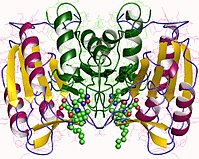
Photo from wikipedia
Caspases are a critical class of proteases involved in regulating programmed cell death and other biological processes. Selective inhibitors of individual caspases, however, are lacking, due in large part to… Click to show full abstract
Caspases are a critical class of proteases involved in regulating programmed cell death and other biological processes. Selective inhibitors of individual caspases, however, are lacking, due in large part to the high structural similarity found in the active sites of these enzymes. We recently discovered a small-molecule inhibitor, 63-R, that covalently binds the zymogen, or inactive precursor (pro-form), of caspase-8, but not other caspases, pointing to an untapped potential of procaspases as targets for chemical probes. Realizing this goal would benefit from a structural under-standing of how small molecules bind to and inhibit caspase zymogens. There have, however, been very few reported procaspase structures. Here, we employ x-ray crystallography to elucidate a procaspase-8 crystal structure in complex with 63-R, which reveals large conformational changes in active-site loops that accommodate the intramolecular cleavage events required for protease activation. Combining these structural insights with molecular modeling and mutagenesis-based biochemical assays, we elucidate key interactions required for 63-R inhibition of procaspase-8. Our findings inform the mechanism of caspase activation and its disruption by small molecules, and, more generally, have implications for the development of small molecule inhibitors and/or activators that target alternative (e.g., inactive precursor) protein states to ultimately expand the druggable proteome.
Journal Title: ACS chemical biology
Year Published: 2020
Link to full text (if available)
Share on Social Media: Sign Up to like & get
recommendations!